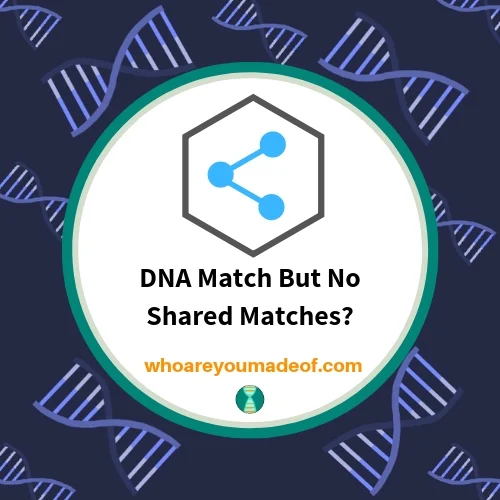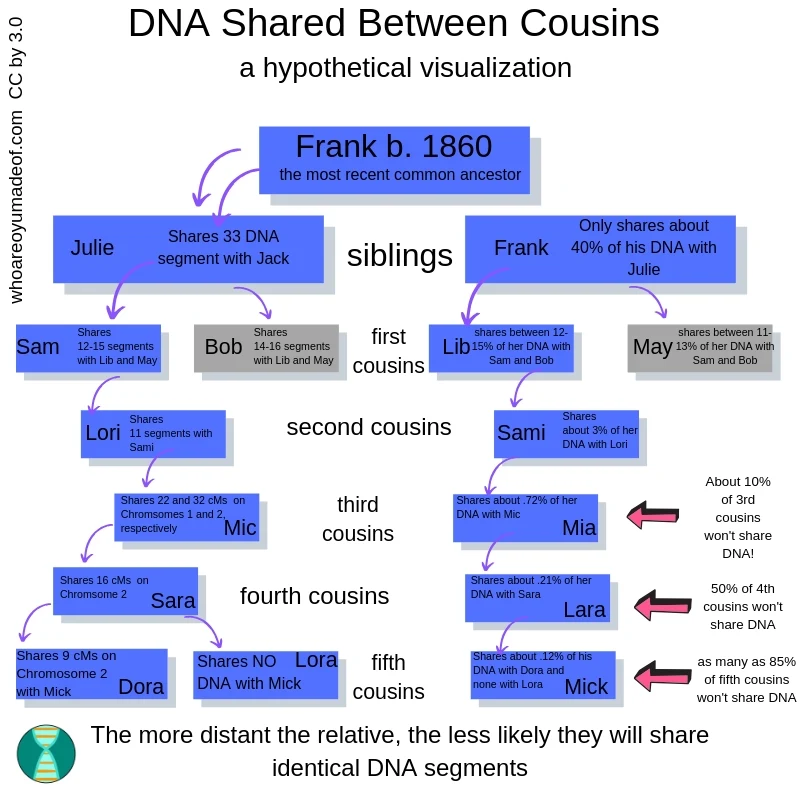Do you have a DNA match, but no shared matches? Why does this happen? Does it mean you aren't really related? How do you figure out which side of your family they are on?
Learn all this, and more, in this post!
Shared matches, sometimes called "matches in common" are one of the first things we should check when a DNA match catches our eye. By seeing which matches we share in common, we can often find clues as to how we might be related.

At the very least, shared matches can help us figure out if a DNA match is paternal or maternal. It is understandably frustrating to see no shared matches.
How is it possible to have a DNA match but no shared matches?
Shared matches are tricky. It is very possible, and actually quite common, to have many DNA matches with whom you share no DNA match in common.
In fact, it is probable that you have more DNA matches with no shared matches vs. DNA matches with shared matches. The only exception to this would be people who have had both of their parents do DNA tests. You'll understand what I mean a little later on in this post.
So, how is it possible? There are a few reasons why this occurs on your DNA match list:
- You might not have DNA matches from all lines of your family tree on your DNA match list
- You have very recent ancestry from another country (similar to reason above)
- Few (or none) of your family members related to you at a third cousin or closer have taken a DNA test with the same company
Many times, especially with more distant matches, this is the reason that you have no shared matches:
- You might not really be related to this DNA match. This only occurs with fourth cousin matches or more distant.
The primary reason behind having no shared matches with a DNA match is due to the way in which DNA is inherited.
Take a look at the chart in the image below to get an idea about how DNA segments are passed down through the generations.

There are two important conclusions that we can draw from the chart above in order to understand the reasons that you have no shared matches with your DNA match.
First, we should notice that the closer relatives share a lot of DNA and many DNA segments. This means that if you have closer relatives do a DNA test, it will be more likely that they will have inherited some of the same DNA segments from the common ancestor that you did, and might share them with a common match.
Second, we see that distant cousins are much less likely to share any DNA. Even if you have a sibling or a first cousin who has done a DNA test, it is much less likely that they would share distant matches with you.
The more distant the cousin, the less likely that you both inherited the same DNA segment from your common ancestor. It is even less likely that you have other distant cousins who inherited such a segment.
Is it possible to not be related to a DNA match?
The final reason for having no shared match with a DNA match that I listed above was that it is possible that you aren't really related to your DNA match.
This is most likely to occur with DNA matches that share only one DNA segment with you, and if that single shared segment is less than 10-15 cM in length. There is no firm guideline on this, however.
The only hard and fast rule is that the larger the DNA segment, more likely you are truly related to your match.
If both of your parents, or all of your grandparents, have done DNA tests, you can resolve this quite easily. If none of your four grandparents or neither of your parents share DNA with your match, then you are not related to your DNA match.
You learned in the section above about the way DNA is passed down. The genetic term for the process is called "recombination".
Take, for example, your mother. You only inherited 50% of her DNA. Your mother has two copies of each chromosome, one inherited from each of her parents (your grandparents). In order to pass down 50% of her DNA to you, her chromosomes "recombined" in order to make a brand-new, completely unique "mixture" of her DNA.
Sometimes, the process of recombination can create small segments that will appear to be identical to small segments from other people. When these segments are large enough, DNA testing software will identify these segments and report the DNA tester as a match, when really they are only coincidentally identical.
The technical term for coincidentally identical is "identical by state". This means that the DNA segment only happens to be identical and is not identical because it was inherited from a common ancestor.
You might be interested to know that the opposite of identical by state (IBS) is "identical by descent" (IBD). IBD DNA segments are identical because they have been passed down through the generations from the common ancestor shared with the match.
How to figure out how you are related to a DNA match with no shared matches
If you have a DNA match that is truly related to you, but you have no shared matches, you'll have to do some research to determine how you are related.
If your DNA match has a family tree attached to their results, or has provided the names of their parents or grandparents to you, you can do some simple family tree building in order to find this likely connection.
How hard it will be to find out which side of the family your match is on depends on how distantly they are related to you and how much both of you know about your family tree.
For some tips on determining how a DNA match is related, check out this post:
How is your DNA match related? Here's a checklist
Conclusion
I hope that this post has helped you understand how it's possible to have a real, legitimate DNA match, but no shared matches. Plus, I hope you got some tips about how to spot when the match might not really be related to you.
If you have any questions about something that you read in this post, I would love to hear from you in the discussion below.
Thanks for stopping by today!


Jan
Sunday 25th of August 2024
Ancestry's new Pro tools shows you ALL shared matches so you can find out if the match you thought shared no other matches with you actually does. It's a game changer when researching more distant ancestral lines in particular. I found a match recently with whom I share over 400 matches. IDK how many are IBS vs IBD, but I've also identified a cluster of over 200 matches related to a previously unknown ancestral line that I've been investigating. Many of these share a common ancestral line with each other proving their relationship. I have a large number of proven matches with whom I share only tiny segments of 8-18 cMs. Pro tools helped me confirm their validity. Pro tools also shows you how a match is related to your shared matches. So before giving up on a match with no shared matches, check out Pro tools. Its a monthly subscription you can cancel any time.
Suzanne G McClendon
Sunday 25th of September 2022
Another reason to have a match on Ancestry with no shared matches (that I didn't see listed above) is the 20cM limit for shared matches. There may be someone who actually does match you and the target match, but if they match either of you at less than 20cM, they will not show up on the Ancestry shared match list. All three of the matches involved have to match each other at least 20cM in order to be on the shared match list.
NZ
Sunday 21st of March 2021
Great article and one that I've already shared with several DNA matches! Thank you.
Mercedes
Tuesday 23rd of March 2021
Thank you!!